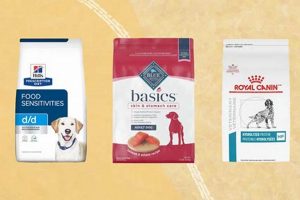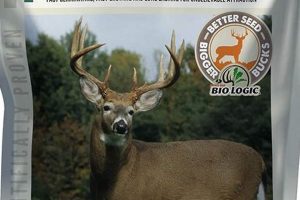Selecting optimal nourishment for canines exhibiting selective eating habits involves understanding the underlying reasons for their preferences and identifying palatable, nutritionally complete options. This often requires careful consideration of factors such as ingredient quality, palatability enhancers, and texture. For example, a dog refusing standard kibble might respond positively to a formulation featuring real meat or a softer, moist texture.
Addressing dietary pickiness is important for maintaining canine health and well-being. Inadequate nutrition can lead to various health problems, including weight loss, muscle weakness, and a compromised immune system. Historically, solutions have ranged from simply adding flavor enhancers to developing specialized dietary formulations designed to appeal to discerning canine palates and address potential underlying medical conditions that contribute to finicky eating habits.
The following sections will explore specific food types, ingredient considerations, feeding strategies, and potential health-related causes contributing to selective eating, thereby providing a comprehensive guide to addressing canine dietary preferences effectively.
Guidance for Addressing Selective Canine Appetite
Employing strategic approaches can positively influence the eating habits of canines with discerning palates. The following tips offer evidence-based suggestions for improving mealtime success.
Tip 1: Rule Out Medical Causes: Prior to adjusting the diet, a thorough veterinary examination is crucial. Underlying medical conditions, such as dental disease or gastrointestinal issues, can significantly impact appetite. Addressing these conditions may resolve the selectivity.
Tip 2: Implement a Structured Feeding Schedule: Offer food for a defined period (e.g., 15-20 minutes) and then remove it, regardless of consumption. This establishes a routine and encourages consumption during designated meal times.
Tip 3: Enhance Palatability: Add small amounts of low-sodium chicken broth, fish oil, or cooked lean meat to the food to increase its appeal. However, moderation is essential to avoid creating dependence on these additions.
Tip 4: Consider Food Temperature: Slightly warming the food can enhance its aroma and palatability, particularly for wet or refrigerated food options. Ensure the food is not excessively hot to prevent burns.
Tip 5: Minimize Treats and Table Scraps: Excessive treats or table scraps can diminish appetite for regular meals. These should be offered sparingly, if at all, and factored into daily caloric intake.
Tip 6: Explore Different Food Textures: Experiment with dry, wet, or semi-moist food formulations to determine which texture is most appealing to the dog. Some picky eaters prefer the moistness of canned food.
Tip 7: Rotate Protein Sources: Introduce variety by alternating between different protein sources (e.g., chicken, beef, fish). This can prevent the dog from becoming bored with a single flavor.
Consistently applying these strategies, while monitoring the dog’s overall health and weight, can lead to improved eating habits and better nutritional intake. Patience and persistence are key components of success.
The subsequent sections will delve into specific food recommendations and ingredient analyses, providing further guidance for addressing canine dietary preferences.
1. Palatability
Palatability, referring to the sensory characteristics that make food appealing, plays a pivotal role in determining the suitability of any food designated as the “best food for picky dogs”. Its importance cannot be overstated, as even the most nutritionally complete formulation will be ineffective if rejected by the intended consumer.
- Flavor Profiles
Flavor profiles significantly influence palatability. Canines exhibit preferences for specific flavors, often driven by their genetics and past experiences. Foods incorporating meat-based ingredients or savory broths tend to be more readily accepted. Understanding prevalent flavor preferences is critical when formulating diets for selective eaters. Manufacturers often conduct palatability trials to determine preferred flavors.
- Aroma Intensity
Odor significantly affects a dog’s willingness to consume food. A robust and appealing aroma can stimulate appetite, especially in individuals with reduced interest in eating. Warming food slightly enhances its aroma, potentially increasing palatability. Conversely, a stale or unpleasant odor can lead to immediate rejection.
- Texture Perception
Texture is a key determinant of palatability. Some canines prefer dry kibble, while others favor wet or semi-moist formulations. Exploring diverse textures, such as soft, chewy, or crunchy options, can unlock preferences. Dental health often influences textural preference, as dogs with dental issues may find hard kibble less appealing.
- Ingredient Quality and Freshness
The quality and freshness of ingredients impact both flavor and aroma, subsequently affecting palatability. High-quality, fresh ingredients tend to be more flavorful and appealing. Conversely, stale or processed ingredients may lack the necessary sensory qualities to entice a selective eater. Ingredient sourcing and processing methods therefore influence palatability.
In essence, palatability encompasses a holistic evaluation of the sensory attributes influencing canine food preferences. By carefully considering flavor profiles, aroma intensity, texture perception, and ingredient quality, it is possible to identify or formulate diets that maximize acceptance and ensure adequate nutritional intake for even the most selective canine companions. A focus on these elements is central to determining the suitability of any candidate for “best food for picky dogs.”
2. Ingredient Quality
Ingredient quality is paramount when determining the suitability of nourishment for canines exhibiting selective eating habits. High-quality ingredients not only contribute to improved palatability but also ensure optimal nutritional value and digestibility, factors crucial for maintaining canine health and well-being. Substandard ingredients may lead to digestive upset, reduced nutrient absorption, and, consequently, further aversion to food.
- Protein Source and Digestibility
The source and digestibility of protein are critical. High-quality protein sources, such as named meat meals (e.g., chicken meal, lamb meal), provide essential amino acids necessary for muscle maintenance and overall health. Protein sources with lower digestibility, like those containing excessive amounts of connective tissue or rendered byproducts, may result in digestive issues and decreased palatability. Selecting foods with easily digestible protein sources supports nutrient absorption and reduces the likelihood of gastrointestinal distress.
- Fat Source and Essential Fatty Acids
The quality of the fat source influences both palatability and the provision of essential fatty acids. Fats derived from named animal sources or plant-based oils (e.g., fish oil, sunflower oil) contribute to the flavor and aroma of the food, making it more appealing. Moreover, these sources supply essential fatty acids like omega-3 and omega-6, which are crucial for skin and coat health, as well as immune function. Rancid or low-quality fats can negatively impact taste and potentially lead to health problems.
- Carbohydrate Source and Fiber Content
The carbohydrate source and fiber content influence digestibility and stool quality. Easily digestible carbohydrates, such as rice or sweet potatoes, provide energy without causing digestive upset. Fiber, derived from sources like beet pulp or cellulose, aids in digestion and promotes healthy bowel movements. Excessive or indigestible fiber can result in loose stools or gas, potentially deterring picky eaters. The appropriate balance of carbohydrates and fiber supports optimal digestive health and nutrient absorption.
- Absence of Artificial Additives
The absence of artificial additives, such as artificial colors, flavors, and preservatives, contributes to the overall quality and potential health benefits of the food. Some canines may exhibit sensitivities or allergic reactions to artificial additives, leading to digestive issues or skin problems. Opting for foods with natural ingredients reduces the risk of adverse reactions and promotes better health outcomes. A clean ingredient list often reflects a higher overall quality and greater suitability for selective eaters.
In conclusion, the selection of nourishment that contains high-quality, digestible ingredients, appropriate fat and carbohydrate sources, and is free from artificial additives is essential when choosing “best food for picky dogs”. These factors contribute to improved palatability, optimal nutrient absorption, and overall well-being, thereby increasing the likelihood of successful feeding and maintaining canine health.
3. Nutritional Balance
The identification of “best food for picky dogs” is inextricably linked to the concept of nutritional balance. Selective eating habits often lead to inadequate intake of essential nutrients, resulting in health deficits over time. Therefore, a food deemed optimal for discerning canines must not only be palatable but also comprehensively balanced in its nutritional profile. A deficiency in even a single essential nutrient can precipitate health problems, undermining the purpose of providing nourishment.
A nutritionally balanced diet for canines should include appropriate levels of protein, fat, carbohydrates, vitamins, and minerals tailored to the dog’s life stage, activity level, and breed. For instance, a food formulated for a senior dog with reduced activity levels will require fewer calories and different proportions of macronutrients compared to a food designed for a highly active working dog. Consider a hypothetical scenario: A picky eater consuming a diet deficient in essential amino acids may develop muscle wasting, weakness, and a compromised immune system. Similarly, a diet lacking essential fatty acids can manifest as skin and coat problems, further affecting the animal’s well-being and potentially exacerbating finicky eating behavior due to discomfort.
In summation, ensuring nutritional balance is not merely a desirable attribute but a fundamental prerequisite for “best food for picky dogs”. Overcoming selective eating habits requires offering a food that is both appealing and complete, mitigating the risk of nutrient deficiencies and promoting long-term health. The understanding of this connection is critical for veterinarians, pet owners, and food manufacturers alike. Challenges remain in accurately assessing individual nutrient needs and developing palatable formulations that meet these requirements, underscoring the need for continued research and development in canine nutrition.
4. Texture Variety
Texture variety plays a significant role in determining the suitability of food for canines exhibiting selective eating habits. Canines, much like humans, possess textural preferences that can dramatically impact their willingness to consume food. Offering diverse textures can overcome sensory aversions and encourage consumption, thereby increasing the likelihood of identifying an optimal diet.
- Kibble Size and Shape
Kibble size and shape influence ease of prehension and mastication, impacting overall palatability. Smaller kibble sizes may be preferable for small breeds or dogs with dental issues, while larger kibble can encourage chewing and potentially reduce the rate of consumption. Kibble shape, whether round, square, or novel designs, can also affect a dog’s acceptance. A dog exhibiting aversion to round kibble may readily consume a square or triangular shape. This illustrates the significance of mechanical factors in food selection.
- Dry vs. Wet Food Contrast
The distinction between dry and wet food formulations offers a fundamental textural contrast. Dry kibble provides a crunchy texture, promoting dental health through abrasive action. Wet food, conversely, offers a soft, moist texture, which can be more appealing to canines with dental problems or those that prefer a heightened sensory experience. Alternating between or combining these textures can enhance overall dietary acceptance. For example, mixing a small amount of wet food with dry kibble can increase palatability without compromising the dental benefits of the kibble.
- Semi-Moist and Soft-Dry Options
Semi-moist and soft-dry food options present an intermediate textural alternative, bridging the gap between dry and wet formulations. These foods offer a softer, more pliable texture than dry kibble, while still maintaining a degree of chewiness. This can be particularly appealing to canines with moderate dental issues or those that prefer a less abrasive texture. The inclusion of humectants in these formulations contributes to the enhanced moisture content and softer texture. A dog rejecting hard kibble might accept a soft-dry alternative more readily.
- Inclusions and Add-ins
The addition of textural inclusions, such as freeze-dried meat pieces or vegetable flakes, can enhance the sensory experience and improve palatability. These inclusions provide a contrasting texture within the main food matrix, adding complexity and stimulating interest. Add-ins like water or low-sodium broth can also alter the overall texture, making the food more palatable to canines with specific preferences. A previously rejected kibble may become acceptable with the addition of warm water, softening the texture and enhancing the aroma.
In conclusion, a focus on texture variety expands the potential for identifying “best food for picky dogs”. Offering a range of textural options, from kibble size and shape to dry, wet, and semi-moist formulations, and incorporating textural inclusions, can overcome sensory aversions and encourage consumption. By addressing the textural preferences of selective eaters, it is possible to improve their overall nutritional intake and health outcomes. This is one crucial aspect when finding the “best food for picky dogs”.
5. Aroma Enhancement
Aroma enhancement is a pivotal factor in formulating sustenance for canines exhibiting selective eating habits. The olfactory sense plays a crucial role in a dog’s initial assessment of food. A palatable aroma can stimulate appetite, even in individuals with a history of food aversion. Conversely, a bland or unappealing aroma can lead to immediate rejection, irrespective of the food’s nutritional content. The connection between aroma and palatability is therefore direct and significant in the context of identifying the “best food for picky dogs.” A prime example involves the common practice of warming wet food slightly. The elevated temperature intensifies the aromatic compounds, making the food more enticing. This effect is rooted in the increased volatility of odor molecules, allowing them to reach the canine’s olfactory receptors more effectively. Food manufacturers often incorporate volatile flavor enhancers, such as hydrolyzed proteins or specific amino acids, to create a more appealing olfactory profile.
The application of aroma enhancement extends beyond simple heating. The selection of ingredients naturally rich in desirable aromas is another key strategy. Fish-based formulations, for instance, often possess a strong, appealing scent to many canines. The use of freeze-dried ingredients also contributes to aroma enhancement, as the freeze-drying process preserves volatile compounds more effectively than traditional cooking methods. Furthermore, certain fats and oils, particularly those derived from animal sources, impart distinctive and attractive aromas. However, care must be taken to avoid rancidity, which can produce unpleasant odors that deter consumption. Consider two scenarios: A food lacking in aromatic compounds is consistently rejected, while an otherwise identical food, with added natural flavor enhancers to boost its aroma, is readily consumed. This demonstrates the practical impact of aroma enhancement on feeding success.
In conclusion, aroma enhancement constitutes a critical aspect of designing diets for selective canines. The strategic manipulation of olfactory stimuli, through warming, ingredient selection, and flavor enhancement techniques, can significantly improve palatability and encourage food consumption. While nutritional balance and ingredient quality remain paramount, the initial olfactory impression can be decisive. Future research might focus on identifying specific aroma compounds that consistently elicit positive responses in canines, thereby allowing for more targeted and effective aroma enhancement strategies in “best food for picky dogs” formulations.
6. Health Considerations
The selection of optimal nourishment for canines exhibiting selective eating habits necessitates careful consideration of health-related factors. Underlying medical conditions or dietary sensitivities can significantly influence a dog’s appetite and food preferences. Therefore, identifying and addressing these health considerations is paramount when determining the “best food for picky dogs.”
- Food Allergies and Intolerances
Food allergies or intolerances can manifest as selective eating. If a dog associates certain ingredients with gastrointestinal discomfort or skin irritation, it may develop an aversion to foods containing those ingredients. Common allergens include beef, chicken, dairy, and wheat. Identifying and eliminating these allergens through an elimination diet or allergy testing is crucial. Hypoallergenic diets, formulated with novel protein sources or hydrolyzed proteins, can minimize allergic reactions and improve food acceptance. For example, a dog sensitive to chicken may thrive on a diet based on salmon or duck. The avoidance of allergens contributes significantly to identifying the “best food for picky dogs” for that specific animal.
- Dental Disease and Oral Health
Dental disease and poor oral health can cause pain and discomfort during eating, leading to selective eating habits. Conditions such as gingivitis, periodontal disease, or tooth abscesses can make chewing difficult and painful. Soft food formulations, such as wet food or softened kibble, may be more palatable for dogs with dental issues. Regular dental cleanings and oral hygiene practices are essential to maintain oral health and encourage food consumption. A dog experiencing dental pain may reject hard kibble but readily accept a soft, moistened diet. Therefore, addressing dental health is an integral component of finding the “best food for picky dogs.”
- Gastrointestinal Disorders
Gastrointestinal disorders, such as inflammatory bowel disease (IBD) or exocrine pancreatic insufficiency (EPI), can significantly affect appetite and food preferences. Dogs with these conditions may experience nausea, vomiting, diarrhea, or abdominal pain, leading to food aversion. Highly digestible diets, formulated with easily digestible protein and carbohydrate sources, can minimize digestive upset. Probiotics and prebiotics may also be beneficial in supporting gut health. A dog with IBD may benefit from a limited-ingredient diet with a novel protein source, combined with probiotic supplementation. Managing gastrointestinal health is vital in identifying suitable nourishment for picky eaters.
- Underlying Medical Conditions
Various underlying medical conditions, such as kidney disease, liver disease, or cancer, can impact appetite and food preferences. These conditions may cause metabolic changes or medication side effects that affect taste and smell. Special dietary formulations, tailored to the specific medical condition, are often necessary to support overall health and encourage food consumption. For example, a dog with kidney disease may require a diet restricted in phosphorus and protein. Addressing underlying medical conditions through appropriate veterinary care and dietary management is essential for identifying the “best food for picky dogs” in these complex cases.
In conclusion, health considerations represent a critical aspect of selecting optimal nourishment for canines exhibiting selective eating habits. Food allergies, dental disease, gastrointestinal disorders, and underlying medical conditions can all contribute to finicky eating behaviors. Addressing these health concerns through appropriate veterinary care and dietary management is paramount in finding a palatable and nutritionally appropriate diet. A holistic approach, considering both health status and palatability, is essential in identifying the “best food for picky dogs” and ensuring optimal well-being.
Frequently Asked Questions
This section addresses common inquiries regarding the selection of appropriate sustenance for canines exhibiting discerning palates, providing clarity on best practices and nutritional considerations.
Question 1: Is specialized nourishment always necessary for a canine exhibiting finicky eating habits?
Specialized nourishment is not always immediately required. A systematic approach, commencing with a veterinary examination to rule out underlying medical conditions, followed by the implementation of structured feeding schedules and palatability enhancement strategies, is advisable. If these methods prove unsuccessful, a specialized diet may be considered.
Question 2: What are the potential risks of feeding a canine a diet that is not nutritionally complete in an effort to appease selective eating habits?
Consistently feeding a canine a diet lacking essential nutrients can result in various health problems, including weight loss, muscle wasting, compromised immune function, and organ dysfunction. Addressing selective eating habits with nutritionally balanced options is paramount.
Question 3: How can palatability be enhanced without compromising the nutritional integrity of the food?
Palatability can be improved through the addition of small quantities of low-sodium broth, fish oil, or lean cooked meat. It is crucial to ensure that these additions constitute a minimal percentage of the overall diet to avoid creating nutritional imbalances or reliance on these enhancements.
Question 4: Are grain-free diets inherently superior for canines exhibiting selective eating habits?
Grain-free diets are not inherently superior for selective canines. While some canines may benefit from the exclusion of grains due to allergies or intolerances, many canines tolerate grains without issue. A thorough evaluation of individual dietary needs and potential sensitivities is necessary before implementing a grain-free diet.
Question 5: What role do treats play in the context of selective eating, and how should they be managed?
Excessive treat consumption can diminish appetite for regular meals, exacerbating selective eating habits. Treats should be offered sparingly, if at all, and should be factored into the daily caloric intake to prevent nutritional imbalances. High-value treats may be used strategically to encourage consumption of regular meals.
Question 6: How frequently should a canine’s diet be changed in an attempt to address selective eating habits?
Frequent and abrupt dietary changes can exacerbate selective eating habits and potentially lead to digestive upset. Dietary transitions should be implemented gradually, over a period of several days, to allow the canine’s digestive system to adapt. Consistency is generally preferred to minimize further aversion.
Addressing selective eating requires a systematic, patient, and nutritionally informed approach. Consulting with a veterinarian or veterinary nutritionist is advisable to tailor dietary strategies to the specific needs of each canine.
The subsequent section will provide practical strategies for transitioning canines to a new dietary regimen effectively.
Best Food for Picky Dogs
The preceding analysis has underscored that identifying the “best food for picky dogs” requires a comprehensive strategy encompassing palatability enhancement, ingredient quality assessment, nutritional balancing, texture diversification, aroma optimization, and, crucially, consideration of underlying health factors. The interplay of these variables determines a food’s suitability for canines exhibiting selective eating behaviors. Overlooking any single element can compromise nutritional intake and overall well-being.
Addressing canine dietary selectivity demands a persistent and informed approach. While inherent challenges persist, prioritizing these factors and actively collaborating with veterinary professionals remains paramount in navigating the complexities of canine nutritional preferences and safeguarding their long-term health. Continued adherence to this understanding can lead to optimal nourishment for even the most discerning canine companions, solidifying the value of diligence and knowledge in canine dietary management.







